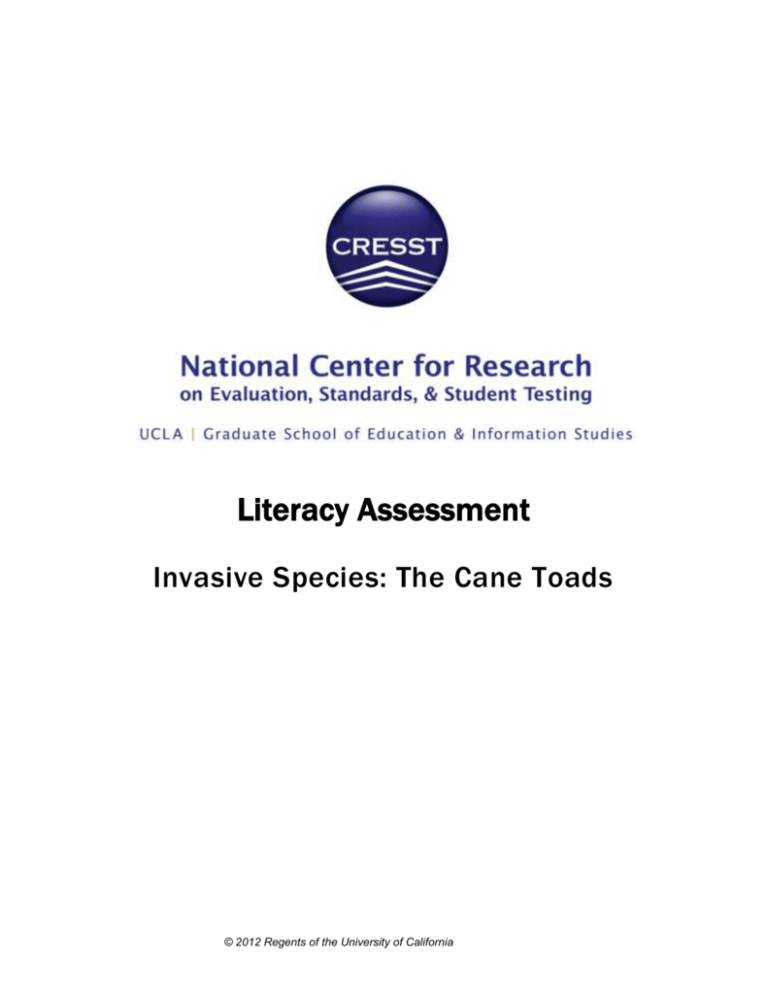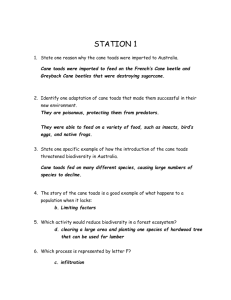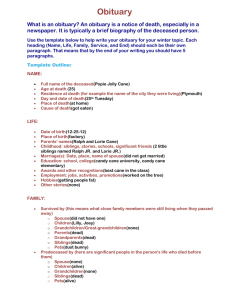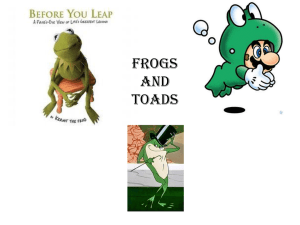Literacy Assessment Invasive Species: The Cane Toads
advertisement

Literacy Assessment Invasive Species: The Cane Toads © 2012 Regents of the University of California ■■ ■ ENGLISH LANGUAGE ARTS 1. Reading Passage – The Cane Toad WC: 668 FK level: 9.7 Lexile: 1240 5 10 In 1935, about 3,000 cane toads were brought to Australia with the hope that they would help serve as “biological controls” to help control pest beetles in the sugarcane industry. The following is an excerpt from the Australian Government’s Department of the Environment, Water, Heritage and the Arts information on dealing with invasive species. Cane toads are native to South and Central America. They are extremely hardy animals and voracious predators of insects and other small prey. The much maligned venomous cane toads earned their bad reputation shortly after being released into the Australian ecology in 1935 with the hope that they would control the destructive cane beetle population. They turned out to be failures at controlling beetles, but remarkably successful at reproducing and spreading themselves. About 3,000 cane toads were released in the sugarcane plantations of north Queensland in 1935. They now number well into the millions, and their still expanding range covers thousands of square miles in northeastern Australia. They are considered pests, and government eradication efforts include asking residents to help collect and dispose of them. Ecology 15 Cane toads forage at night in a wide variety of habitats. The toad is a ground-dwelling predator, primarily eating terrestrial and aquatic insects and snails. Toads will even take food left out for pets. The toads can also be accidentally transported to new locations, for example in pot plants or loads of timber. 20 Cane toads need constant access to moisture to survive. Instead of drinking, they absorb water through the skin on their belly — from dew, moist sand or any other moist material. If forced to stay in flooded conditions, cane toads can absorb too much water and die. They can also die from water loss during dry conditions. In Australia there are no specific predators or diseases that control the population of cane toads. 25 The toads can breed at any time of year but seem to prefer the weather conditions that occur with the onset of the wet season. They will lay their eggs in still or slow-moving waters. Females can lay 8000–30 000 eggs at a time. In comparison, most Australian native frogs typically lay 1000–2000 eggs per year. Cane toad eggs hatch in two or three days and the tadpole stage lasts between four and eight weeks. In tropical conditions, the toadlets can reach adult size within a year, but this may take twice that long in colder climates. continue reading Literacy for NPS – Invasive Species: The Cane Toads - v14 ■■ 2 ■ ■■ ■ ENGLISH LANGUAGE ARTS Impact of the Cane Toad 30 35 40 45 The cane toad defends itself through poison and is poisonous, to varying degrees, during all its life stages. Adult cane toads produce toxin from glands over their upper surface, but especially from bulging glands on their shoulders — these exude venom when the toad is provoked. While some birds and native predators have learned to avoid the poison glands of adult toads, other predators are more vulnerable and die rapidly after ingesting toads. Toads contain poisons that act on the heart and on the central nervous system. The poison is absorbed through body tissues such as those of the eyes, mouth and nose. Their effects on Australia's ecology include the depletion of native species that die eating cane toads; the poisoning of pets and humans; depletion of native fauna preyed on by cane toads; and reduced prey populations for native insectivores, such as skinks. The arrival of cane toads in Kakadu National Park was linked to a marked decline in some native predators in the park. However, based on current evidence it appears that some native predator species which were heavily impacted when the toads arrived have made rapid adaptations (both behavioral and physiological) allowing for the potential for population recovery in the longer term. Adult cane toads may compete with native animals, particularly for shelter. For example, a 2004 study showed that cane toads ruined one-third of nest attempts of ground-nesting rainbow bee-eaters by usurping their nest burrows and preying upon their eggs and young nestling. Control of Cane Toads 50 There is unlikely to ever be a wide-ranging method available to control cane toad populations across Australia. Researchers are beginning to understand the toad’s impact on native fauna and to appreciate the ways in which native species are adapting to the presence of cane toads and recovering from the impact of their arrival. Protecting our most vulnerable native species on a local scale is the focus of current planning around cane toads. Literacy for NPS – Invasive Species: The Cane Toads - v14 ■■ 3 ■ ■■ ■ ENGLISH LANGUAGE ARTS Adapted from: http://www.environment.gov.au/biodiversity/invasive/publications/cane-toad/factsheet.html, Commonwealth of Australia http://animals.nationalgeographic.com/animals/amphibians/cane-toad/ Glossary hardy – capable of surviving in difficult conditions fauna – the animals of a particular region or habitat voracious – having a very eager approach to an activity usurping – to take over or occupy Literacy for NPS – Invasive Species: The Cane Toads - v14 ■■ 4 ■ ■■ ■ ENGLISH LANGUAGE ARTS Writing Task In the 1930s, prior to the development of effective chemical tools for controlling agricultural pests, many biologists were hopeful that the use of “biological controls” would be valuable in pest control. A proposal is made to introduce a poisonous prey species to Australia to help control the spread of the cane toad. Using information from both readings and the map, explain why this use of another biological control would likely have negative consequences. Your essay will be scored on how well you: demonstrate an understanding of the impact of the cane toads in Australia state and support your thesis with information from the readings and the map provide at least four examples from the readings and the map to support your thesis statement present your essay in a logical and well organized manner use textual evidence from the readings and the map to support your ideas use proper punctuation, spelling, and grammar An exemplary response will thoroughly explain why introducing another poisonous species could negatively affect native species while failing to control the cane toad population. The response will use the cane toad as an example, e.g. The cane toad depleted several predator species, and the new poison species could do the same to predators of small prey, like skinks. A poisonous species may also be a hazard to humans and their pets. Without natural predators, the new species would consume the resources of native animals. For example, the cane toads displaced to rainbow bee-eaters from their dens. A new species may spread quickly into new areas, just as the cane toad. The cane toads had no natural controls and reproduced quickly. The cane toads also adapted to their new environment over time, accelerating their migration into habitable regions. The new species may fail to control the cane toads. The cane toads did not eliminate the cane beetles, perhaps because they preyed on insects and snails found near the ground. Literacy for NPS – Invasive Species: The Cane Toads - v14 ■■ 5 ■








